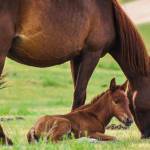Effect of Blue Light on Pregnant Mares

In recent years, some breeders have exposed their broodmares to blue LED light with the goal of advancing the breeding season. Early onset of estrus provides several advantages to the breeder. Most notably, mares bred in midwinter will deliver foals early the following year, potentially increasing their value as race and show prospects. Researchers recently set out to evaluate the effects of prepartum exposure to blue LED light on pregnancy, foaling, and foal development.*
Twenty Warmblood mares were used in a study that spanned two consecutive breeding seasons. In the first year, mares were subjected to an extended photoperiod of blue LED light directed in a single eye from 8:00 a.m. to 11:00 p.m. by wearing commercially available light masks beginning in mid-December. In the second year, the same mares served as controls. One day after the birth of each foal, researchers recorded withers height and weight. Hair growth in mares and foals was also measured one day after foaling.
The researchers found:
- Gestation was shortened in light-treated mares when compared to control mares, an average of 330 days versus 338.5 days;
- Foals born to light-treated mares had lower withers height, similar body weight, and took less time to stand compared with foals born to control mares;
- Foals born to light-treated mares had shorter hair length compared to foals born from control mares; and
- Hair regrowth in light-treated mares was reduced.
In sum, the researchers indicated that “prepartum extension of day length using blue LED light had clear effects on pregnancy in mares and their newborn foals,” some of which may be advantageous in the management of certain mares. Shortened gestation, for example, might allow for earlier rebreeding of mares following foaling. While the foals of light-treated mares were slightly smaller than those produced by control mares, no negative effects on foal maturity were observed.
Although the use of blue LED light in pregnant broodmares is novel, breeders have long known that mares require appropriate nutrition for optimal fertility. Aside from the provision of good-quality forage and a well-formulated concentrate, broodmares often benefit from targeted supplementation.
“Kentucky Equine Research offers many products that are appropriate for breeding mares, including EO-3, an omega-3 supplement rich in DHA and EPA, and Nano-E, a natural, water-soluble source of vitamin E. These products have strong antioxidant properties that help with the integrity of reproductive tissues, particularly in older broodmares,” said Peter Huntington, B.V.Sc., M.A.C.V.Sc., director of nutrition at Kentucky Equine Research.
Seek the assistance of a qualified equine nutritionist when designing diets for broodmares.
*Lutzer, A., C. Nagal, B.A. Murphy, J. Aurich, M. Wulf, C. Gautier, and C. Aurich. 2021. Effects of blue monochromatic light directed at one eye of pregnant horse mares on gestation, parturition, and foal maturity. Domestic Animal Endocrinology 78:106675.








